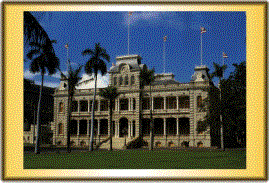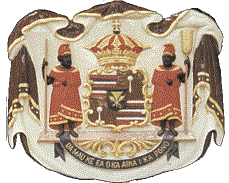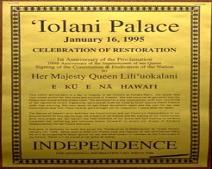
Hawaii’s Statehood
Alexandria Martin
Hawaii and Nineteenth-Century Commerce
The exact date is unknown and probably will remain so forever.
But sometime after the beginning of the Christian era, Polynesians first
set foot on these islands. Linguistic and cultural evidence suggests that the
first inhabitants came from the Marquesas group, to the north of Tahiti. During
the thirteenth and fourteenth centuries, waves of immigrants from Tahiti
overwhelmed and absorbed the original people. Since the earliest Hawaiians were
likely somewhat smaller than later immigrants, they may form the basis for the
legends of the menehunes, who were pictured by the later Hawaiians as
hardworking elves.
Hawaii assumed importance in the east-west fur trade and later as the
center for the Pacific whaling industry. Captain James Cook, the great Pacific
explorer, happened upon the islands during his third voyage in 1778.
Hawaii's long isolation ended at that moment.
Soon, King Kamehameha the Great embarked on his successful campaign to
unite the islands into one kingdom. At
about the same time of the decline of the Asian fur trade Hawaii extensive
sandalwood resources began to deplete in the 1830’s.
Despite the circumstances, Hawaii assumed importance in the east-west fur
trade and later as the center for the Pacific whaling industry.
Change came at a rapid pace, as both education and commerce assumed
growing importance. The old
Hawaiian culture disappeared rapidly under the onslaught of new ways, new
peoples, and new diseases, to which the previously isolated Hawaiians were all
too susceptible. Whaling and the
provisioning of the whaling fleet brought new money to the island economy.
At times, as many as 500 whaling ships wintered in Hawaiian ports,
principally Lahaina and Honolulu to pick up the valuable goods that Hawaii
possessed.
In 1835, the first commercial production of sugar cane began, and this crop took on ever increasing economic importance, especially after the decline of the great whaling fleets. Native Hawaiians did not take kindly to the tedious labor of a plantation worker and, in any case, the native population had been seriously depleted by disease. Thus, there began the importation of labor from Asia and the Philippines and other areas of the world. It is this varied population that gave rise to the immense variety of Hawaii's present inhabitants. Threatened constantly by European nations eager to add Hawaii to their empires, sugar planters and Americans businessmen began to seek annexation by the United States. This, too, would give them the advantages of a sugar market free of tariff duties.

Sugar was by
far the principal support of the islands; and profits and prosperity hinged on
favorable treaties with the United States, Hawaiian sugar's chief market,
creating powerful economic ties. The plantation owners were, for the most part,
the descendants of the original missionary families who had brought religion to
the islands in the wake of the whaling ships. As ownership of private property
came to the islands, the missionary families wound up owning a great deal of it.
Hawaii has little in the way of mineral wealth, so the land was useful only for
agriculture. In a day when unrefrigerated sailing ships such as Captain Matson's
"Falls Of Clyde" were the only means to ship produce to the U.S.
Mainland, sugar, and to a lesser extent coconuts, were the only produce that
could survive the sea voyage.
Imperialistic
Tactics
The American citizens themselves, the plantation owners, were rankled by
the fact that the US government actually made more profits from their sugar then
the plantation owners themselves did. To evade the tariff, it became necessary
to the plantation owners that Hawaii cease being a separate and sovereign
nation. Finally, a treaty of
reciprocity was negotiated in 1875 and this brought new prosperity to Hawaii.
American wealth poured into the islands seeking investment.
Political control by Hawaiian royalty and the growing influence of
Americans began to cause conflict. In
1887, during the reign of Lili`uokalani' s brother, King Kalakaua, a group of
planters and businessmen, seeking to control the kingdom politically as well as
economically, formed a secret organization, the Hawaiian League. Membership
(probably never over 400, compared to the 40,000 Native Hawaiians in the
kingdom) was predominantly American, led by Lorrin A. Thurston, a lawyer and
missionary grandson. Their goal, for now, was to "reform" the
monarchy. But what was "reform" to the Americans was treason to the
people of Hawaii, who loved and respected their monarchs.
It is important to recall that, unlike the hereditary rulers of Europe,
Hawaii’s last two kings were actually elected to that office by democratic
vote. Kalakaua and his sister Lili`uokalani were well educated, intelligent,
skilled in social graces, and equally at home with Hawaiian traditions and court
ceremony. Above all, they were deeply concerned about the well being of the
Hawaiian people and maintaining the independence of the kingdom. They saw no
reason to relinquish their independence solely to make already rich Americans
richer still. The Hawaiian League's more radical members favored the king's
abdication, and one even proposed assassination. They eventually decided that
the king would remain on the throne, but with his power sharply limited by a new
constitution of their making. Killing him would be a last resort if he refused
to agree. Many Hawaiian League members belonged to a volunteer militia, the
Honolulu Rifles, which was officially in service to the Hawaiian government, but
was secretly the Hawaiian League's military arm.
Kalakaua was compelled to accept a new Cabinet composed of league
members, who presented their constitution to him for his signature at `Iolani
Palace. The reluctant king argued and protested, but finally signed the
document, which became known as the Bayonet Constitution. As one Cabinet member
noted, "Little was left to the imagination of the hesitating and unwilling
sovereign, as to what he might expect in the event of his refusal to comply with
the demands made upon him."
The Bayonet Constitution greatly curtailed the king's power, making him a
mere figurehead. It placed the actual executive power in the hands of the
Cabinet, whose members could no longer be dismissed by the king, only by the
Legislature. Amending this constitution was also the exclusive prerogative of
the Legislature. The Bayonet Constitution's other purpose was to remove the
Native Hawaiian majority's dominance at the polls and in the Legislature. The
righteous reformers were determined to save the Hawaiians from self-government.
The privilege of voting was no longer limited to citizens of the kingdom,
but was extended to foreign residents -- provided they were American or
European. Asians were excluded -- even those who had become naturalized
citizens. The House of Nobles, formerly appointed by the king, would now be
elected, and voters and candidates for it had to meet a high property ownership
or income requirement -- which excluded two-thirds of the native Hawaiian
voters. While they could still vote for the House of Representatives, to do so
they had to swear to uphold the Bayonet Constitution.
In 1889, there was an uprising of the native islanders against the constitution, which had been forced on King Kalakaua two years earlier. `The last King of Hawaii, King David Kalakaua, built Iolani Palace. The seat of government of the Kingdom of Hawaii, `Iolani Palace had electricity and telephones installed several years before the White House.



The Palace remained a
royal residence until Queen
Lili`uokalani, the King's sister and successor, was deposed and
the Hawaiian monarchy overthrown in January 1893. The queen was imprisoned in
the Palace for eight months in 1895 by the unlawful Provisional Government,
charged with treason for attempting to restore Hawaii’s sovereignty. The
Palace served as capitol of the Provisional Government, Republic, and Territory
in the State of Hawaii. At that time the Palace was vacated and restoration
begun. It is now a museum under the direction of the Friends of `Iolani Palace,
who continue restoration efforts. (`Iolani Palace continues to be a focal point
in efforts to restore Hawaii sovereignty and independence.) The rebellion was
suppressed. With Queen Liliuokalani
on the throne, the Americans formed a Committee of Safety and declared the
monarchy ended. Shortly, after the Republic of Hawaii was established.
On
August 12, 1898, a treaty of annexation was negotiated with the United States
and a formal transfer of sovereignty was made with the promise of eventual
statehood. However, the fact was ignored that Hawaiians submitted a petition to
the United States Congress with 29,000 signatures, as well as petitions to the
Republic of Hawaii asking that annexation be put to a public vote. Hawaiians
were never permitted to vote on the issue.
In all, three separate Treaties of Annexation were sent to the Congress.
All three failed. In the end, Hawaii was annexed by a joint resolution of the
Congress. But Congress did not have the legal authority to do so, because a
joint resolution of the Congress has no legal standing in a foreign country,
which is what Hawaii remained, even under the provisional government.
Sovereignty
of Hawaii was formally transferred to the United States at ceremonies at `Iolani
Palace on Aug. 12, 1898. Sanford Dole spoke as the newly appointed governor of
the Territory of Hawaii. The Hawaiian anthem, ''Hawaii Pono `I" -- with
words written by King Kalakaua -- was played at the Hawaiian flag was lowered,
and replaced by the American flag and "The Star-Spangled Banner." The
Hawaiian people had lost their land, their monarchy and now their independence.
The American plantation owners were now free of import tariffs; making it a
small matter that the Hawaiian people had lost their independence along the way.
Hawaii
became a territory of the United States in 1900.
The pattern of growth then began to accelerate even more rapidly. Hawaii
remained a territorial possession of the United States for many years. The
military presence illegally begun during the Spanish American war continued to
grow, including the naval base at Pearl Harbor. The plantation families grew
richer and richer, while the original Hawaiian people were marginalized, often
homeless in their own homeland. The animosity between Hawaiians and Americans
exploded into public view during the celebrated Ala Moana rape case, in which
famed lawyer Clarence Darrow argued for the defense. The thin veneer of a
tropical paradise, crafted for the emerging tourist industry, was shattered in
moments by the anger shown on both sides.
Hawaii Becomes a State
In
1941, Franklin Delano Roosevelt decided that the best way to get a reluctant
America into a war with Hitler was to "back door" a war by luring
Japan into an attack against the United States. By cutting off oil exports to
Japan, Roosevelt forced Japan to invade the Dutch East Indies, and by placing
the U.S. Pacific Fleet at Pearl, Roosevelt made an attack at Pearl the mandatory
first move in any military move by Japan in any direction. The U.S. Navy
set up its giant Pacific headquarters at Pearl Harbor and the Army built a huge
garrison at Schofield Barracks.
The
attack on Pearl Harbor marked America's entry into World War II, and Hawaii and
its citizens played a major role in the conflict. The postwar period saw many
rapid changes with the descendants of plantation laborers rising to the highest
prominent in business, labor, and government. Following World War II, Hawaii was
placed on the list of non self-governing territories by the United Nations, with
the United States as trustee, under Article 73. Under Article 73 of the U.N.
charter, the status of a territory can only be changed by a special vote, called
a plebesite, held among the inhabitants of the territory.
That plebiscite is required to have three choices on the ballot. The first choice is to become a part of the trustee nation, in Hawaii's case that meant to become a state. The second choice was to remain a territory. And the third choice, required by article 73 of the UN Charter, was the option for independence. For Hawaii, that meant no longer being a territory of the United States and returning to being an independent sovereign nation. In 1959 Hawaii's plebiscite vote was held, and again, the United States government bent the rules. The plebiscite ballot only had the choice between statehood and remaining a territory. No option for independence appeared on the ballot as was required under the UN charter. Cheated out of their independence yet again, Hawaii proved eager to take on the full responsibilities of statehood. Under the leadership of Hawaii's last delegate to Congress, John A. Burns, the 86th Congress approved statehood and President Dwight D. Eisenhower signed the bill into law on March 18, 1959. Hawaii was admitted as the 50th state of the union on August 21, 1959.
|
"The seal of the state of Hawaii features a grand image of King Kamehameha I, royally dressed and holding his staff, and a classic rendition of Liberty, holding the Hawaiian flag, on either side of a heraldic shield. A Phoenix rises up from native foliage. The date 1959, representing Hawaii's statehood, displays prominently. Wording on the seal reads "State of Hawaii" across the top. On the bottom of the seal is a quote attributed to King Kamehameha III, after a British admiral attempted a takeover in 1843: 'Ua mau ke ea o ka aina i ka pono", translated as "The life of the land is perpetuated in righteousness.'" --quote from official Hawaiian state government website
|
|
|
|

Many
years later in 1988, a study by the United States Justice Department concluded
that Congress did not have the authority to annex Hawaii by joint resolution.
The ersatz annexation was a cover for the military occupation of the Hawaiian
Islands for purposes related to the Spanish American war. It was not until on
November 23, 1993, President Clinton signed United States Public Law 103-150,
which not only acknowledged the illegal actions committed by the United States
in the overthrow of the legitimate government of Hawaii, but also that the
Hawaiian people never surrendered their sovereignty.
The
latter is the most important part of United States Public Law 103-150 for it
makes it quite clear that the Hawaiian people never legally ceased to be a
sovereign separate independent nation. There is no argument that can change that
fact. United States Public Law 103-150, despite its polite language, is an
official admission that the government of the United States illegally occupies
the territory of the Hawaiian people. In 1999, the United Nations confirmed that
the plebiscite vote that led to Hawaii's statehood was in violation of article
73 of the United Nations' charter. The Hawaii statehood vote, under treaty then
in effect, was illegal and non-binding. (The same is true of the Alaska
plebiscite).
As
of now, there are things that the Hawaiian people are forced to deal with seeing
that they are a technically a state of the United States. One of the issues is
the destruction of many historic landmarks, such as Walgreen’s purchasing the
Kahiki to demolish it for a new drugstore. The Kahiki Supper Club is listed in
the National Register of Historic Places (1997). The Kahiki is an intact example
of a mid-twentieth century cultural icon, the Polynesian restaurant. Built in
1960-61, it represents the heightened interest in Polynesia following World War
II. Entertainment and leisure activities focusing on or derived from the South
Seas were especially popular during the 1950s and early 1960s. Movies and
television shows featured the Polynesian setting, while hula hoops, luaus,
surfing, and beach music allowed people from coast to coast to celebrate the
South Seas culture.
As
in all debates it is only fair to hear both sides. Walgreen's spokesman Michael
Polzin says, "Walgreen’s
has a policy against destroying historic buildings... The company just doesn't
think the Kahiki makes the cut. This building is unusual, but it's not very
old." The Kahiki is one of many historical landmarks being torn down
because companies from the United States are starting to expand their business
there. Alongside the loss of historical landmarks, there is the fact that the
Hawaiian youth are losing their culture by becoming more Americanized rather
than Hawaiian. Increasingly, Hawaii's venerable traditions are being
replaced by inauthentic recreation of those traditions for European and mainland
tourists.
Bibliographic Sources
The Apology Bill, Public Law 103-150, 103d Congress, Joint Resolution, November 23, 1993.
Bell, Roger, Last Among
Equals: Hawaiian Statehood and American Politics, Honolulu:
University of
Hawaii Press, 1984.
Hannum, Hurst, Autonomy, Sovereignty, and Self-Determination:
and The Accommodation of
Confliction Rights, Philadelphia:
University of Pennsylvania, 1990.
MacKenzie, Melody Kapilialoha, ed., Native Hawaiian Rights Handbook, Honolulu: Native
Hawaiian Legal
Corporation/Office of Hawaiian
Affairs, 1991.
Additional Reading
Dougherty, Michael. To Steal a Kingdom: Probing Hawaiian
History. Waimanalo, Hawaii: Island
Style Press, 1992.
Dudden, Arthur Power. The American Pacific: From the Old China
Trade to the Present. New
York: Oxford University Press, 1992.
Coffman, Tom. Nation Within: The Story of America's Annexation
of the Nation of Hawaii,
Island Styles Press, 1998.
Hawaiian Statehood on the Web
This
website deals with the reaction of the Hawaiian people on statehood issues:
http://honolulu.miningco.com/citiestowns/alaskahawaii/honolulu/gi/dynamic/of
This website provides a chronology of
important events in Hawaii's quest for
statehood:
http://honolulu.miningco.com/citiestowns/alaskahawaii/honolulu/gi/dynamic/offsite.htm